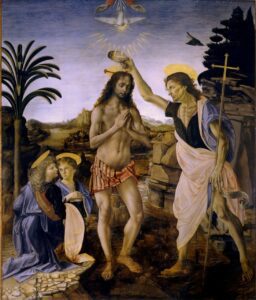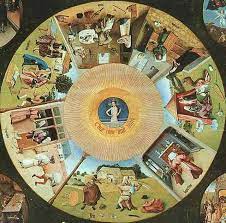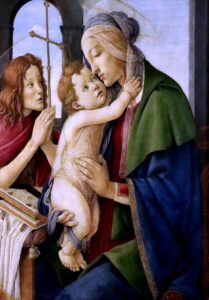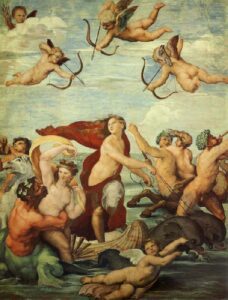Renaissance Humanism in art marks a pivotal shift where individual experience and realism took center stage.
It’s a movement that celebrated the human form, emotion, and intellect, challenging the rigid religious norms of the Middle Ages.
We’ll explore how artists like Leonardo da Vinci and Michelangelo Buonarroti infused humanism into their masterpieces, creating a legacy that redefined art history.
Get ready to uncover the essence of humanism that still resonates in the art world today.
Understanding Renaissance Humanism In Art
Renaissance Humanism marked an intellectual movement that unfolded in the heart of Europe during the 14th to 17th centuries.
It boasted a renewed curiosity in the classical ideas of Greece and Rome, which emerged distinctly in the arts.
Our focus on this transformative period reveals how a human-centered philosophy reshaped the cultural landscape, leaving an indelible imprint on visual arts.
In scrutinizing the masterpieces from this era, we recognize the humanist infusion in each brushstroke.
Artists like Da Vinci and Michelangelo captured the beauty of the human form, emotion, and individuality with unprecedented precision.
They embarked on a quest to portray humans not as mere subjects but as protagonists in their narratives – a stark contrast to the earlier Medieval Art, which often relegated human figures to symbolic roles within religious contexts.
Our analysis of prominent artworks – such as Mona Lisa and The Last Supper by Leonardo da Vinci, alongside Michelangelo’s David and the Sistine Chapel ceiling – illustrates the defining characteristics of Renaissance Humanism:
- A shift towards realism and anatomical accuracy,
- Emphasis on perspective and depth to convey three-dimensional space,
- Portrayal of subjects with individual personalities and emotions.
This period, infused with humanist thought, was not limited to visual arts.
We see its profound influence seep into literature, architecture, and politics.

Ideas first captured on canvas and in marble spread to wider societal norms, questioning established orders and elevating human reason and experience.
Delving deeper into the ethos of Renaissance Humanism, we observe a harmonious marriage between art and science.
This bond is epitomized by the ‘Vitruvian Man’ and underscores how humanism championed a holistic understanding of the world.
Our artists were not mere creators; they were polymaths, blending scientific inquiry with artistic Try to ignite an age of enlightenment.
The Shift From Religious Dogma To Individual Experience
The dawn of the Renaissance signified a pivotal shift in art – away from the confines of religious dogma and towards the intricacies of individual human experience.
This period saw artists breaking from the medieval tradition of serving as mere visual translators of biblical narratives.
Instead, we find artworks imbued with the richness of personal expression and emotional depth.
Renaissance Humanism played a crucial role here as it encouraged artists to explore the classical ideas of antiquity, which celebrated human achievements and the beauty of the natural world.
Works like The Birth of Venus by Botticelli convey an almost tangible sense of human emotion and physicality unheard of in earlier religious art.
Art during this era didn’t abandon religious themes but approached them with a new perspective.
Rather than solely focusing on divine figures, artists began to infuse their work with a sense of personal inquiry and philosophical contemplation.
The frescoes of Raphael, for example, illustrate a harmonious blend of religious content with a strikingly human-centric focus.
We observed an emergence of portraiture as a popular genre, as humanism championed the worth of the individual:
- Artists like Titian showcased not just the physical likeness but the character and status of their subjects,
- Leonardo da Vinci’s Mona Lisa epitomized this trend, capturing a remarkably lifelike presence and leaving lasting questions about her enigmatic expression.
The transformation from spiritual servitude to personal narrative allowed for a broader range of topics and artistic freedom.

Architects and sculptors, alike, rediscovered classical techniques and forms – the columns and domes of Roman times were revitalized in the grand designs of the era, echoing the humanist reverence for the past’s intellectual achievements.
Celebrating The Human Form, Emotion, And Intellect
Renaissance Humanism placed immense value on the study of the human form.
Artists like Leonardo da Vinci and Michelangelo became pioneers in depicting the body with anatomical precision.
Their works, such as The Vitruvian Man and David, stand as testaments to this era’s dedication to combining art and science to reflect the beauty and complexity of humanity.
The focus on emotion and intellect was equally
Artworks were infused with a sense of personality and emotional depth previously unseen.
Pieces like Raphael’s School of Athens not only showcased masterful composition and perspective but also captured the intellectual fervor of the time through the representation of historical philosophers engaged in thoughtful discourse.
Alongside these innovations, Renaissance artists explored:
- The subtleties of light and shadow to create mood and drama,
- New techniques to depict textures and fabrics with stunning realism,
- Portrayal of subjects in diverse states of mind, from serene to tumultuous.
Our fascination with Renaissance Humanism is rooted in its revolutionary approach to art’s potential.
Both in technique and subject matter, artists challenged the status quo, paving the way for future generations to see art not just as religious or didactic, but as a celebration of the full spectrum of human experience.
Leonardo Da Vinci: The Epitome Of Renaissance Humanism
Leonardo da Vinci stands as a towering figure in the world of Renaissance art, embodying the spirit of humanist philosophy in his work.
His relentless pursuit of knowledge through observation and experimentation made him the quintessential “Renaissance man,” weaving together the disciplines of art, science, engineering, and anatomy with unparalleled mastery.
In The Last Supper, da Vinci conveys the complexity of human emotion and interaction through composition and the use of perspective.
This masterpiece not only captures the narrative of a pivotal moment but also showcases each disciple’s individual response, bringing a new depth to biblical storytelling.
Da Vinci’s contributions transcended traditional boundaries, merging the realistic with the innovative:
- His sketches of the Vitruvian Man symbolized the blend of art and science,
- Techniques like sfumato allowed for the subtle gradation of tone and color,
- Studies of anatomy led to depict the human body with exceptional realism.
The magnificence of works like Mona Lisa lies in their ability to connect with viewers on an intimate level.
Da Vinci’s skill in capturing the subtlest expressions invites us into a silent dialogue with the subject, making her seem alive and present across the centuries.
Da Vinci’s legacy is a testament to the transformative power of Renaissance Humanism in art.
His works continue to inspire and challenge us, as they reflect the endless potential of the human mind when it is driven by curiosity and a love for both beauty and knowledge.
Michelangelo Buonarroti: Transcending Humanism In Art
In the panorama of Renaissance Humanism, Michelangelo Buonarroti stands as a towering figure whose work transcends time.
His profound impact on art can be seen through his sculptures and paintings, which are revered for their emotional intensity and technical mastery.

Michelangelo’s deep understanding of the human form and his ability to capture the human spirit set the bar for excellence in Renaissance art.
Creating some of the period’s most iconic pieces, Michelangelo explored themes that went beyond mere representation – he breathed life into marble and fresco.
The Statue of David and the Sistine Chapel Ceiling represent more than artistic achievements; they speak to the very essence of what it means to be human.
- David – a symbol of strength and youthful beauty,
- Sistine Chapel Ceiling – a monumental narrative that exemplifies the grandeur of divine creation and the complexities of biblical figures.
Our understanding of Renaissance Humanism is enriched through the lens of Michelangelo’s work, which unifies sublime beauty with philosophical depth.
His artistry extends an invitation to ponder not just the aesthetics but also the human condition itself.
Through this introspection, Michelangelo elevates the conversation of what art is and its purpose in our lives.
Michelangelo’s approach to sculpture and painting mirrored the era’s shift towards realism and away from the stylized forms of the medieval period.
In his art, we see a celebration of the human experience, cast in the luminous glow of his genius.
His mastery of form and movement came through rigorous study and a keen observation of anatomy.
These skills did not only ornament churches and palaces but also changed the trajectory of how future generations would perceive and create art.

Michelangelo’s influence continues to intrigue and inform contemporary artists and filmmakers, pushing them towards new frontiers of creativity and expression.
Through his legacy, we remain connected to the rich tapestry of Renaissance Humanism and its enduring impact on the arts.
The Enduring Legacy Of Renaissance Humanism In Art
We’ve journeyed through the remarkable era of Renaissance Humanism and its indelible mark on art.
This movement wasn’t just a fleeting chapter in history—it sparked a creative revolution that celebrated human potential and beauty.
Artists like Leonardo and Michelangelo didn’t just paint or sculpt; they breathed life into their work, inviting us to see the world through a lens of curiosity and intellect.
Their legacy isn’t simply found in galleries or history books; it’s woven into the fabric of modern creativity, challenging us to pursue excellence and authenticity in our own artistic endeavors.
The spirit of Renaissance Humanism continues to resonate, reminding us that at the heart of great art is the profound and enduring celebration of humanity itself.
Frequently Asked Questions
What Is Renaissance Humanism?
Renaissance Humanism was a cultural movement during the 14th to 17th centuries that emphasized a shift from religious dogma to individual experience, exploring classical ideas, human achievements, and the beauty of the natural world in art.
How Did Renaissance Humanism Affect Art?
Renaissance Humanism affected art by encouraging artists to move away from solely depicting biblical narratives and explore a broader range of topics, including portraiture that showcased physical likeness, character, and status.
What Did Renaissance Humanism Bring Back From Classical Traditions In Art?
Renaissance Humanism revived classical techniques and forms, allowing architects and sculptors to rediscover and reemploy the artistic principles from ancient Greece and Rome.
Who Were Some Key Artists Of The Renaissance Humanism Period?
Key artists of the Renaissance Humanism period included Leonardo da Vinci and Michelangelo Buonarroti, who pioneered the depiction of the human body with anatomical precision and captured the human spirit in their works.
What New Genres Became Popular During The Renaissance Humanism Period?
During the Renaissance Humanism period, portraiture emerged as a popular genre that went beyond physical likeness and began to reflect the character and status of the individuals depicted.


